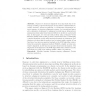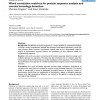62 search results - page 4 / 13 » CONTRAlign: Discriminative Training for Protein Sequence Ali... |
RECOMB
2007
Springer
14 years 7 months ago
2007
Springer
Abstract. Sequence to structure alignment is an important step in homology modeling of protein structures. Incorporation of features like secondary structure, solvent accessibility...
BMCBI
2010
13 years 7 months ago
2010
Background: The ability to design thermostable proteins is theoretically important and practically useful. Robust and accurate algorithms, however, remain elusive. One critical pr...
BMCBI
2006
13 years 7 months ago
2006
Background: In recent years protein structure prediction methods using local structure information have shown promising improvements. The quality of new fold predictions has risen...
BMCBI
2007
13 years 7 months ago
2007
Background: Predicting a protein’s structural class from its amino acid sequence is a fundamental problem in computational biology. Much recent work has focused on developing ne...
BMCBI
2008
13 years 7 months ago
2008
Background: Classification of protein sequences is a central problem in computational biology. Currently, among computational methods discriminative kernel-based approaches provid...


